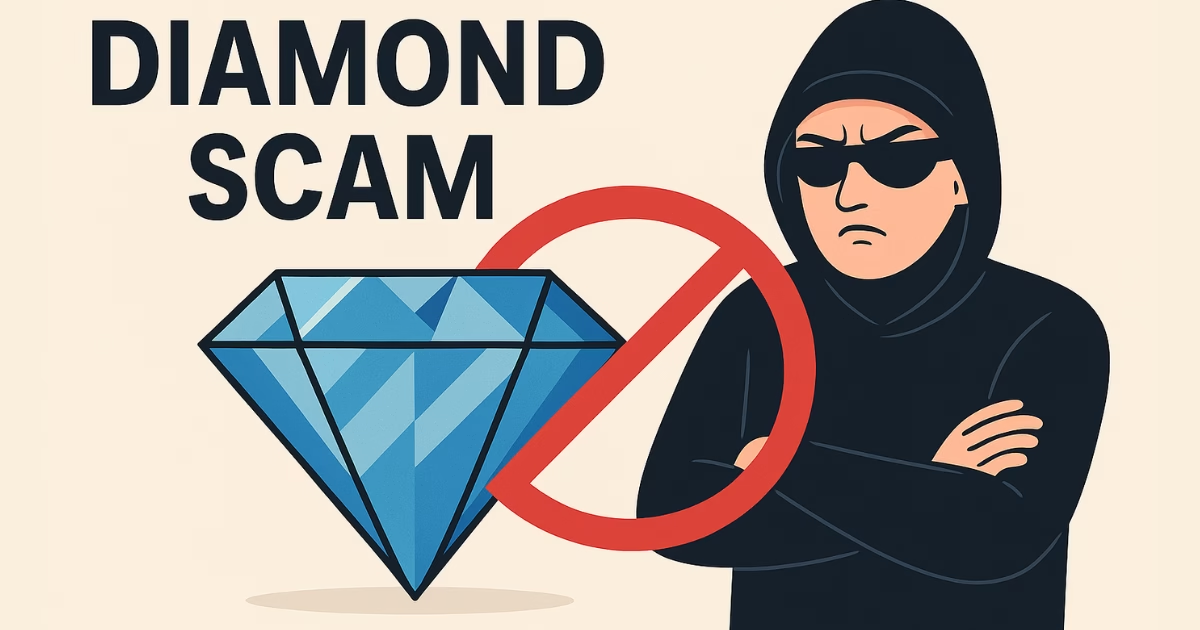Diamonds have long been a symbol of love, success, and luxury. For decades, people have spent fortunes on these sparkling stones, believing they were making a wise investment or showing deep affection. But behind the glitter and glamour, there lies a darker side of the industry — the diamond scam. Many buyers, whether first-timers or seasoned collectors, have fallen victim to hidden traps, overpriced stones, and clever marketing tricks. It’s not just about fake diamonds; sometimes the real deception is in the pricing, grading, or selling practices themselves. Understanding how the diamond scam works is crucial for anyone thinking about buying a diamond. In this blog post, the goal is to shed light on the common scams, explain how they operate, and share expert advice on how to stay safe. Before you buy your next diamond, make sure you know the real risks.
What Is the Diamond Scam?
The diamond scam covers a range of dishonest practices that trick buyers into paying more than a diamond is truly worth. At its core, it’s about misinformation, overpricing, and sometimes even outright fraud. Scammers use emotional marketing, fake certifications, and confusing pricing systems to make diamonds seem rarer and more valuable than they really are.
There are several forms of diamond scams today. Some involve selling low-quality or synthetic stones as high-end gems. Others play on people’s emotions during engagements or anniversaries, pressuring them to overspend without asking the right questions. Even reputable-looking stores sometimes use tricky tactics, like inflated “retail” prices with constant fake discounts. Online scams add another layer of danger, where buyers might receive a different stone than advertised — or nothing at all.
Understanding the true nature of the diamond scam is the first step in avoiding costly mistakes.
The History Behind the Diamond Scam
The story of the diamond scam goes back more than a century. In the late 1800s, a company called De Beers took control of nearly all the world’s diamond mines. They created an artificial shortage by limiting how many diamonds reached the market. By doing this, they made diamonds seem rare and precious, even though large supplies actually existed.
De Beers also launched one of the most successful marketing campaigns in history. Their slogan, “A Diamond is Forever,” connected diamonds with eternal love. It convinced generations that a diamond engagement ring was not just tradition but a requirement.
This marketing magic made people believe that diamonds were a wise investment. In reality, the resale value of a diamond is often far less than the purchase price. The diamond scam started with controlling supply, emotional marketing, and hiding the truth about a diamond’s real worth.
Common Types of Diamond Scams Today
The diamond scam has evolved with time. Here are the most common traps buyers fall into today:
1. Retail Markup Scams
Many jewelry stores mark up diamond prices by 100% or more. They set a fake “retail price” and then offer big “discounts” to make buyers feel like they are getting a bargain.
2. Fake Diamond Sales
Sometimes, sellers pass off lookalike stones like cubic zirconia or moissanite as real diamonds. Without proper testing, most people can’t tell the difference.
3. Investment Scams
Buyers are promised that diamonds are a safe investment. They are sold overpriced stones and later discover their “investment” has little resale value.
4. Certification and Appraisal Fraud
Some stores provide certifications from fake or unreliable labs. These reports exaggerate the diamond’s quality, tricking buyers into overpaying.
5. Online Diamond Scams
Online stores with flashy websites may deliver lower-quality stones than promised, or nothing at all. Some vanish after collecting payments.
Understanding these tricks helps buyers stay one step ahead of scammers.
Warning Signs You Are Falling for a Diamond Scam
Recognizing the warning signs can save you from falling into a diamond scam. Here are some major red flags:
- Too-good-to-be-true discounts: Genuine high-quality diamonds rarely come with massive price cuts.
- Suspicious certifications: If the seller refuses to provide GIA or AGS reports, be cautious.
- High-pressure sales tactics: Scammers push buyers to make decisions quickly without proper research.
- Vague answers to questions: Honest jewelers are transparent about the 4Cs (cut, clarity, color, carat).
- No clear return or refund policy: Scammers usually avoid offering easy returns.
Trust your gut. If something feels off, it usually is.
How to Avoid a Diamond Scam: Expert Tips
Being prepared is the best way to protect yourself from a diamond scam. Experts recommend the following:
- Always demand certification: Stick with diamonds graded by respected labs like GIA or AGS.
- Get an independent appraisal: Before purchasing, have a trusted appraiser verify the stone.
- Research prices: Compare similar diamonds online before visiting a store.
- Understand the 4Cs: Knowledge about cut, clarity, color, and carat helps you make smarter choices.
- Buy from reputable sources: Choose stores with strong reviews and long histories.
- Read the return policy: A real jeweler stands behind their products with clear terms.
A little homework goes a long way toward avoiding scams.
The Rise of Lab-Grown Diamonds and New Scams
Lab-grown diamonds have become popular in recent years. They look identical to mined diamonds but cost far less. While lab diamonds are a great option for many, they have also created new forms of the diamond scam.
Some dishonest sellers misrepresent lab-grown stones as natural ones, charging higher prices. Others don’t disclose the origin of the diamond unless asked. Since lab diamonds have different resale values, this deception can cost buyers thousands.
To avoid being scammed, always ask directly if the diamond is lab-grown. Check that the certificate clearly states the stone’s origin. Trusted sellers will be honest about it upfront.
Real-Life Diamond Scam Stories
Real-world examples of the diamond scam show how common and costly it can be:
- Investment Trap: In the 2000s, a company in London tricked hundreds of people into buying “investment-grade” diamonds at inflated prices. Victims lost millions and had no way to resell the stones.
- Fake Certification Case: A New York jeweler was caught selling diamonds with fake GIA certificates. Many buyers thought they were purchasing top-quality stones but ended up with lower-grade gems.
- Online Disappearance: Several online stores have popped up, taken orders during sales events, and disappeared without delivering anything.
These stories highlight why smart buying is so important.
Why the Diamond Industry Is Still Risky Today
Even with better technology and consumer awareness, the diamond industry still carries risk. Not all sellers follow ethical standards. Some exploit legal loopholes, especially in online sales.
Luxury marketplaces often have weak regulations. In many countries, there are no strict rules about diamond grading or disclosure. This leaves too much room for scammers to operate freely.
Most customers also don’t have enough education about diamonds. Without the right knowledge, they rely too much on the seller’s word, making them easy targets for a diamond scam.
Also Read: A Nostalgic Dive Into Early 2000s Social Media Trends
Conclusion: Protect Yourself from the Diamond Scam
Buying a diamond should be a joyful experience, not a stressful gamble. Unfortunately, the diamond scam is real and growing more sophisticated every year.
By learning about the scams, recognizing warning signs, and taking smart steps before purchasing, buyers can protect themselves from fraud. Choosing certified stones, trusted sellers, and doing independent research are all powerful ways to stay safe.
Diamonds may shine bright, but only knowledge can help you see clearly through the illusions. Stay informed, stay alert, and make sure your sparkle doesn’t come with regrets.
FAQs About the Diamond Scam
1. What is a diamond scam?
A diamond scam is any dishonest practice where sellers trick buyers into paying more for a diamond than it’s worth. This can involve fake certifications, overpriced stones, synthetic diamonds sold as natural, or even selling fake diamonds altogether.
2. How can I tell if a diamond is real or fake?
The safest way is to request a GIA or AGS certification. You can also do simple tests like checking if the stone fogs up quickly when breathed on (real diamonds clear fast). However, expert testing with a jeweler is always best.
3. Are lab-grown diamonds part of the diamond scam?
Lab-grown diamonds themselves aren’t a scam. The scam happens when sellers don’t clearly tell buyers that the diamond is lab-grown, or when they charge natural diamond prices for lab stones.
4. Why are diamonds marked up so much in jewelry stores?
Jewelry stores often use high markups to cover costs like rent, marketing, and commissions. Some stores also inflate prices just to offer fake “discounts” later, which tricks buyers into thinking they’re getting a great deal.
5. What should I look for when buying a diamond to avoid scams?
Always buy certified diamonds from trusted sellers. Research prices beforehand, know the 4Cs, ask questions, and avoid high-pressure sales. Make sure there’s a clear return policy too.

Hi, I’m Shafy Ali – a curious mind and passionate writer at Celiac Magazine. I cover a little bit of everything, from everyday tips and how-tos to deeper dives into topics that spark conversation. I enjoy turning research into readable, relatable content that informs and inspires. Whatever the subject, I aim to keep it clear, engaging, and genuinely useful.

